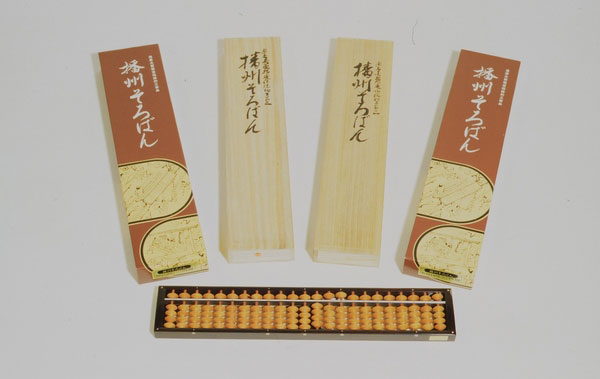
- Writing tools
- Hyogo
Banshu abacus Banshu soroban
"Read, write, do math with an abacus"
Beautiful diamond-shaped chamfered abacus
Description
What is Banshu abacus ?
Banshu abacuses (called Banshu soroban in Japanese) are produced in the city of Ono, Hyogo prefecture. Ono, an agricultural area blessed with a warm climate, started abacus production during its off-season.
Japanese abacuses are traditional tools that use columns lined with beads quickly moved with the fingers to do calculations. This craft has a production process divided into several phases and became one of Hyogo's representative traditional crafts due to high productivity and great techniques.
The origin of this craft is the Otsu abacus, which was originally introduced from the Nagasaki prefecture, but developed in the city of Otsu, Shiga prefecture. Otsu was a transportation hub bustling with merchants, as it has easy access to the commercial capitals of Osaka and Kyoto. Therefore, Otsu flourished with abacus production.
The daily use of Banshu abacus in schools or by merchants gradually increased its production volume while developing its product range to include different colors and unique shapes meant to draw children's attention. Although the recent proliferation of computers and calculators has brought about decreasing demand for abacuses, the Banshu abacus remains a vital item for arithmetic education at home and in school.
History
The history of the abacus goes back to the late Muromachi period (1336-1573), when abacuses were introduced from China to Nagasaki prefecture. Then, they were brought to the city of Otsu in Shiga prefecture, which is near the business districts Osaka and Kyoto, encouraging abacus production and commercialization.
When Hideyoshi TOYOTOMI (powerful feudal lord) captured Miki Castle in the city of Miki, Hyogo prefecture (near the city of Ono) in 1580, some residents escaped to Otsu. The residents who had learned how to make abacuses began production after returning home to Hyogo prefecture, which is the root of Banshu abacuses.
During the Edo period (1603-1868),terakoya or private temple schools taught children how to read, write, and calculate on the abacus. As a result, abacuses soared in popularity especially in business districts keeping up with the spread of terakoya, resulting in eight abacus wholesalers and over two hundred subcontractors by the end of the period.
Following the first Sino-Japanese war (1894-1895), the city of Ono had newly invented bead making machinery, which enabled mass production of abacuses. Moreover, the craft grew in demand as the economy grew after World War II after the School Education Law passed, which guaranteed nine years of free education. Abacuses have experienced a slowdown in demand due to the widespread use of computers but still boast full production with over 530,000 pieces made every year.
General Production Process
- 1. Frame making
A frame is made out of accumulate timber or ebony wood imported from Africa or Indonesia. This process involves splitting the woods into large pieces, cutting large pieces into smaller pieces, and processing a plank to the dimensions of a frame.
- 2. Beads production
This craft undergoes over a hundred steps by expert artisans. Tamakezuri is a process that shapes wood into abacus beads after raw wood is selected and dried completely. Abacus beads are mainly made of boxwood, a wood hard enough to break an axe. Boxwood, ebony wood, and red sandalwood is used for the beads of premium abacuses. There is a new technique of making beads out of a round long bar of wood.
- 3. Making rods
The abacus rods are mainly made of Japanese timber bamboo, while smoked bamboo is used for premium abacuses. A bamboo stick is cut to a specified size and split into smaller pieces which are rounded and smoothed.
Banshu abacus has a divided production process system that requires abacus frames, beads, and rods to be processed separately. All the materials are transferred to other artisans for assembly.
- 4. Frame processing
The top, bottom, and side frame boards are planed to give a smooth surface, then joint holes and grooves are made. The holes are made to align with the bamboo axles and back rods, while grooves are made for fitting the backboards. Backboards are made out of a specialized board and holes are made in the beam that goes in between the top and bottom frames.
The axles are fit in the holes, grooves are made on the beams, and then celluloid strings are embedded in the grooves. The bamboo axles are cut and shortened for assembly. All the pieces of the abacus are temporarily joined and any necessary adjustments are made before the final assembly.
- 5. Rods and beads
The rods are placed in holes on the beam. Then, beads are threaded on the rods.
- 6. Assembly
After beads are threaded on the rods, the bottom frame, right frame, backboard, and back rod are attached sequentially.
- 7. Making joint holes
This process is to make three types of joint holes, which are called medake dome, urabo dome and sumi dome. The joint holes are made on the top and bottom frames, then an aluminum wire is pierced and cut with scissors. This ensures the back rods, axles, and frames are properly built to form a durable abacus.
- 8. Polishing
This process is about polishing the outer frame which is where the hands grip the abacus, and scraping the tip of the cut wire. Polish is applied to the craft with sandpaper or muku tree leaves that add shine.
Where to Buy & More Information
Hyogo Furusatokan
-
Address
-
Tel.+81-78-252-0686
-
ClosedJanuary 1
-
Business Hours10am to 8pm
-
Website
See more Writing tools
- Kumano brushes
- Ogatsu inkstone
- Akama inkstone
- Unshu abacus
- Banshu abacus
- Nara brushes
- Suzuka inksticks
- Toyohashi brushes
- Kawajiri brushes
- Nara Ink































































































































































































































































































